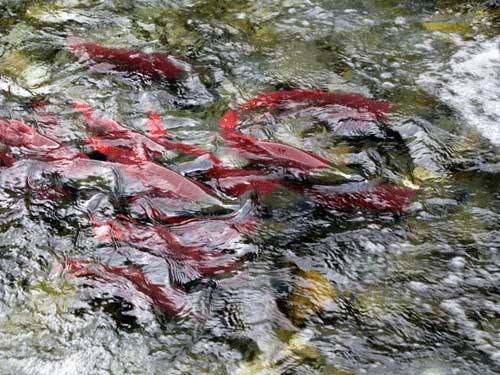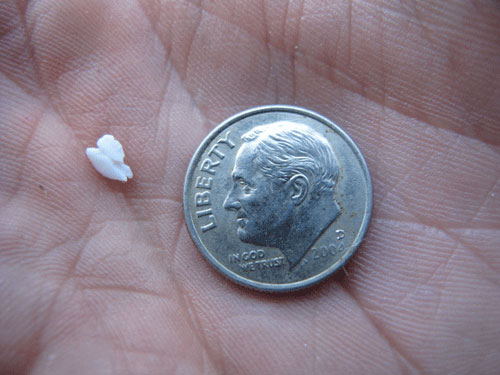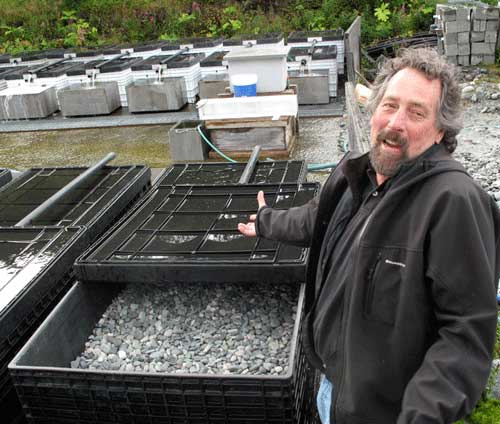
A high-country Eden for sockeye salmon
August 17, 2011
"There are seven springs in the canyon," says Gary Martinek, manager of this salmon hatchery just off the Richardson Highway between Summit and Paxson lakes. "From summer to winter the water temperature only varies 3 degrees. This water is the key to the hatchery."
Red salmon gather at a Gulkana Hatchery fish weir that prevents them from going upstream on the east fork of the Gulkana River.
"It's the largest sockeye hatchery in the world," Martinek says. "Two-hundred and sixty miles from the ocean." Martinek, an employee here for more than three decades, has the exuberant tone of a proud father as he shows off long rows of more than 100 plastic fish totes filled with gravel and fertilized salmon eggs. The flowing springwater keeps the totes unfrozen on the coldest days of winter, allowing as many as 97 percent of those eggs to become young sockeye (red) salmon. In April and May, hatchery workers stock the tiny fish in Summit, Paxson, and Crosswind lakes. They accomplish the first two transfers by truck and hose, the latter by airdrop of about 10 million fish from a small plane. This seeding of the Gulkana River system with red salmon — born of the eggs and sperm of wild and hatchery salmon from the hatchery's "egg-take pond" — enhances one of the richest fisheries in Alaska. Commercial fishermen take thousands of Copper River reds in the Gulf of Alaska, and personal-use and subsistence fishermen capture thousands more with dipnets and fishwheels. According to Steve Moffitt, an Alaska Department of Fish and Game biologist in Cordova, commercial fishermen have harvested about 500,000 Gulkana-hatchery-born red salmon from the open ocean in 2011. During the past 10 years, subsistence and personal-use fishermen have taken about 28,000 hatchery fish each year from the Copper River. By Moffitt's estimate, about two out of every 10 dipnetted Copper River reds was born at the Gulkana Hatchery. Even the most experienced fishery biologists can't tell a red salmon born in the Gulkana Hatchery from one that has lived its entire five-year life in the wild. To sort out the fish, managers use a method born of years of trial and error — each Gulkana Hatchery fish has a bright band on its otolith bone that can be seen only with a sophisticated microscope.
A red salmon’s otolith bone.
Beginning in June, biologists with the Alaska Department of Fish and Game collect otoliths from fish caught in both the Gulf of Alaska and the Copper River. In a Cordova lab, they slice the bones — about the size of a grain of rice — mount them on slides, and send them to the University of Alaska Fairbanks. There, in a lab operated by Ken Severin, Miriam Braun uses a refrigerator-size electron microscope to tell whether the bone samples came from a fish born at the Gulkana Hatchery. Just a few days after the fish were caught, Braun relays the information to fishery managers in Cordova.
Hatchery manager Gary Martinek shows a “salmon incubator” at the Gulkana Hatchery, where many Copper River red salmon are born.
Back at the Gulkana Hatchery, Martinek explains that red salmon emerge from more than 100 distinct spawning grounds along the Copper River system, but many of the fish enjoyed in restaurants in San Francisco and dining rooms throughout Alaska have their beginning in the verdant little valley that is home to the Gulkana Hatchery. "We're doing this to provide fish for everyone," he says. "We want the fish to be caught."
This column is provided as a public service by the Geophysical Institute, University of Alaska Fairbanks, in cooperation with the UAF research community.
E-mail your news &
photos to editor@sitnews.us
|
||


